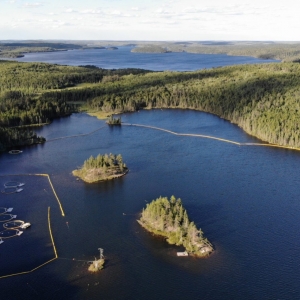Fresh, September 5, 2023: Drought and High Demands for Crops Drive Groundwater Overdraft in Minnesota
September 5, 2023
Fresh is a biweekly newsletter from Circle of Blue that unpacks the biggest international, state, and local policy news stories facing the Great Lakes region today. Sign up for Fresh: A Great Lakes Policy Briefing, straight to your inbox, every other Tuesday.
— Christian Thorsberg, Interim Fresh Editor
This Week’s Watersheds
- Drought and demand for french fries are pushing commercial and private growers to exceed Minnesota irrigation limits, causing groundwater shortages.
- First Nation Chiefs in Ontario have unanimously opposed a land swap that would see hundreds of acres of wild wetlands being used for agriculture or development.
- Long Point, Ontario, a hamlet on the shore of Lake Erie and one of the world’s ‘most diverse biosphere zones,’ receives nearly $5 million for protections.
- New York state legislators have introduced a bill to build wind turbines in Lake Erie and other state lakes.
A new tree species, bred specifically for Midwest climates, shows potential in Wisconsin for cleaning polluted groundwater.
“[The InnovaTree] also absorbs a lot of water, making it ideal for a process called ‘phytoremediation.’ That’s a fancy term for ‘cleaning up pollution from soil and water.’ For example, if you plant a wide area of the InnovaTree between a landfill and a river, the trees will intercept and absorb toxins in the water as it flows downhill and into the river.” — Jeff Jackson, an educator for the Natural Resources Research Institute at the University of Minnesota Duluth.
The InnovaTree, a cross between the eastern cottonwood and black poplar, made its “debut” this summer at Hauser’s Superior View Farm, less than two miles from the shores of Lake Superior, Wisconsin Public Radio reports.
Designed by researchers at the University of Minnesota Duluth, the tree is bred to thrive in northern Midwest climates. It grows between 5 and 8 feet per year, “which is 64 percent faster than other hybrid poplars on the market.”
Researchers hope its phytoremediation abilities will be a nature-based solution for the problem of groundwater contamination and runoff.
In context: How Big Ag Pollutes America’s Waters and Makes Money Doing It
Fresh from the Great Lakes News Collaborative

- What’s being done about plastic trash getting into the Great Lakes? — Bridge Michigan
- Court rules against Michigan’s restrictions on PFAS in water — Michigan Radio
- University of Windsor to build capacity for Canada’s national urban parks — Great Lakes Now
The Great Lakes News Collaborative includes Bridge Michigan; Circle of Blue; Great Lakes Now at Detroit Public Television; and Michigan Radio, Michigan’s NPR News Leader. We work together to produce news and information about the impact of climate change, pollution, and aging infrastructure on the Great Lakes and drinking water. This independent journalism is supported by the Charles Stewart Mott Foundation. Find all the work here.

The Lead
In 2021, as a summer of sweltering heat and drought ravaged Minnesota and its crops – corn, soybeans, and potatoes for McDonald’s french fries — growers throughout the state had little choice but to pump an increased amount of groundwater via irrigation canals to their land.
The result: A collective overdrawing of 6.1 billion gallons of water, relative to state limits, the New York Times reports.
The effects proved devastating for some nearby communities and the overall state of water in the Land of 10,000 Lakes. According to the Times, local residents reported needing to travel great distances to friends’ or families’ homes in order to shower or cook. In Warren, Minnesota, officials needed to “physically lower the pump at the town’s well by 63 feet in order to keep providing drinking water to more than 1,500 residents, including those in a hospital and nursing home.”
Last year, more than 7,000 permits to use irrigation wells were issued in Minnesota. Farmers are required to self-report their water usage, and despite lawmakers’ concerns, the outside enforcement of water usage is still no guarantee.
The White Earth Nation is concerned that their streams and lakes, upon which they depend for fishing and the growing of culturally significant manoomin (wild rice), will deteriorate as aquifers dry and chemical runoff, largely due to pesticides, continues.
This year, per the Times, they “passed a measure that requires tribal officials to sign off on any new irrigation wells that farmers want to install within five miles of the reservation.”
In Context: Minnesota Tribe Sets Enforceable Rules To Safeguard Wild Rice and Water Supply
In the News
Greenbelt Scandal: Designated in 2005, the Greenbelt comprises 2 million acres of protected wetlands, rivers, lakes, forests, and farmland in Ontario. But the provincial government has recently been moving forward with a series of land swaps — developing Greenbelt land and replacing it with new, protected acres elsewhere. Much of the removed territory, including a newly proposed land swap, comprises the traditional homes of First Nations peoples who are adamantly fighting back against the government’s actions, which they say are illegal, CTV News Toronto reports.
Long Point: In the spring of 2022, Ottawa pledged $11.3 million over three years to help reverse the loss of biodiversity within the country’s 19 United Nations-designated biosphere reserves. Nearly $5 million is going now to fund conservation efforts at Long Point, a hamlet on the north shore of Lake Erie. Home to forests, wetlands, and nearly one-quarter of Canada’s at-risk species, Long Point is also a crucial flyway and stopover for hundreds of species of migratory birds, the Stratford Beacon Herald reports.
Looking Ahead
Wind Turbines in Lake Erie: At a New York state legislation hearing earlier this month, lawmakers introduced a bill proposing the construction of wind turbines in “lakes within the state,” including Lake Erie, Erie News Now reports. Advocates for the proposal are citing the potential to increase clean energy outputs, while those against say that the construction and required transmission lines needed to operate the turbines would upset the lakebed and fragile ecosystem health.
Upcoming Events
September 6-7 — Great Lakes Dredging Team Meeting — learn more
September 8-9 — Great Lakes-St. Lawrence Legislative Caucus Annual Meeting — learn more
September 13-14 — Great Lakes Areas of Concern Conference — register
September 15 — Anaerobic Digester Workshop: The future of manure and food waste management — learn more
September 18 — EPA Great Lakes Advisory Board public meeting — register
September 19-21 — Lakebed 2030 Conference — register
Other News
Heat Wave Hydrants: During a two-day heat wave in Chicago last week, nearly 900 open-hydrant complaints — and 21 low water pressure complaints — were filed, WBEZ Chicago reports
Micron Technologies: The company’s new semiconductor plant, currently under construction, will require 48 million gallons of water per day, Spectrum Local News reports. “Much of it” will come from Lake Ontario.
Christian Thorsberg is an environmental writer from Chicago. He is passionate about climate and cultural phenomena that often appear slow or invisible, and he examines these themes in his journalism, poetry, and fiction.






Leave a Reply
Want to join the discussion?Feel free to contribute!